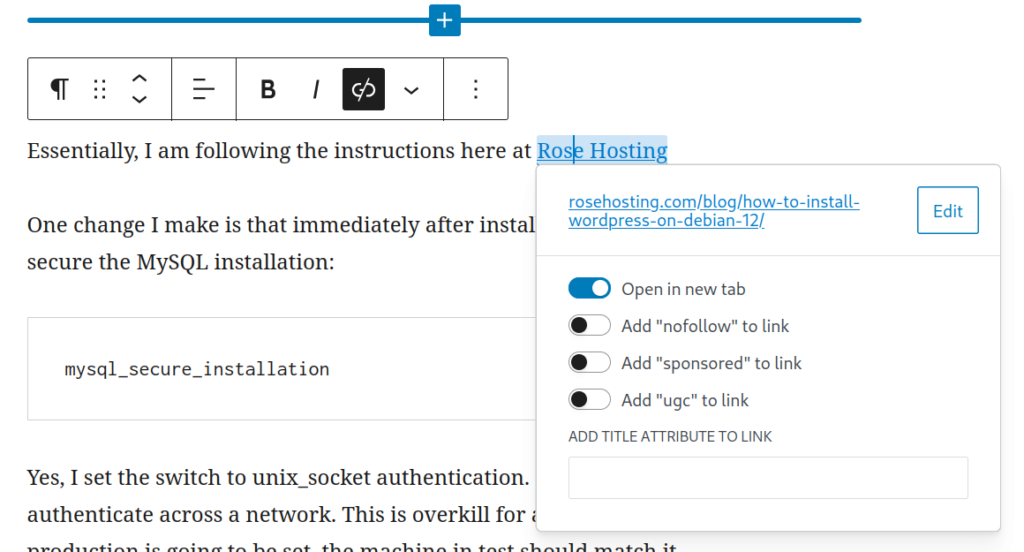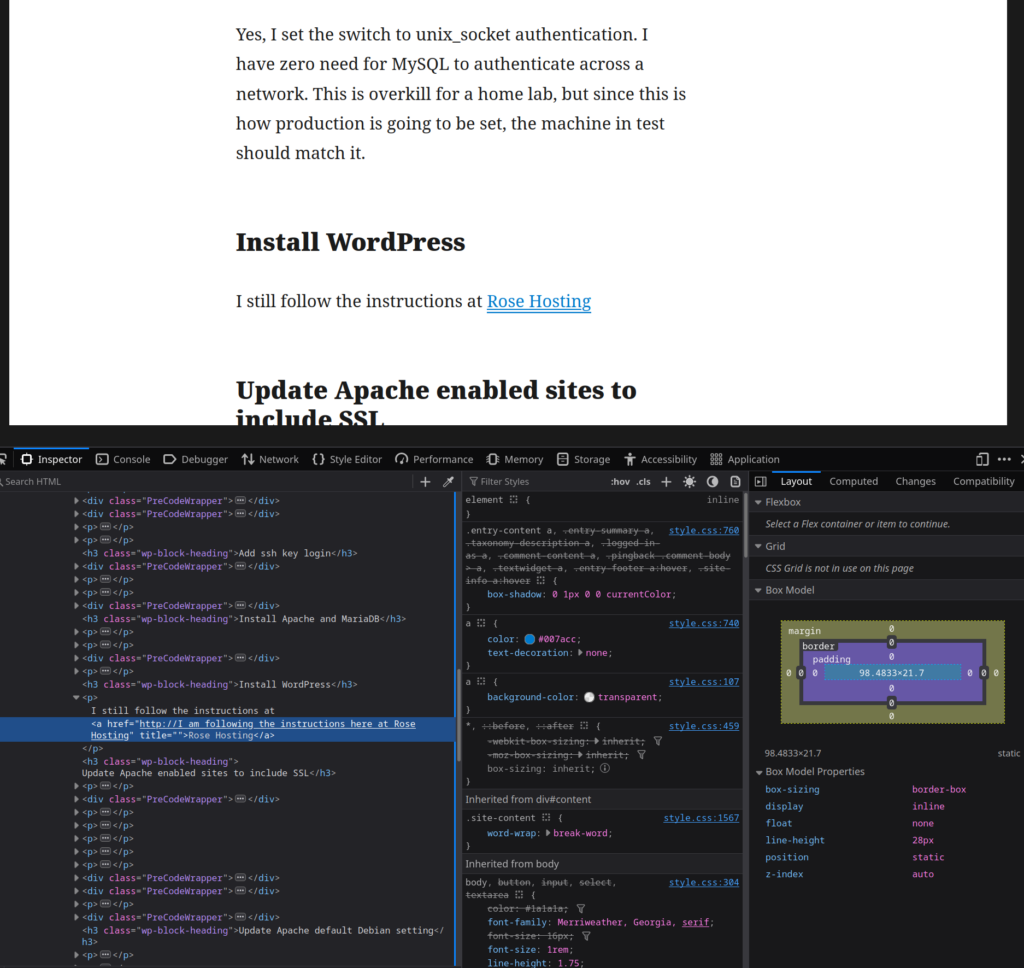Joy. Not.
I get to do a migration from my existing website to a new instance of WordPress on a new (virtual) machine.
This is the website I maintain as a volunteer service for a fellowship I am a part of. I’m the web servant, and have been since 2017. I originally inherited the static HTML website from a gentleman who wrote it in Microsoft FrontPage 98. But a few months later, a member showed me an app that helps our members find meetings. That app was written by a member, and is easiest to implement as a WordPress plugin. “I guess I’m learning WordPress now” was my 2017 motto.
Indeed, I wrote a whole new website using WordPress and incorporated the meeting finder plugin. I’ve been maintaining the website ever since. Five months ago, I migrated it from Bitnami on Amazon Lightsail, to straight Debian on Linode. For five months, it ran fine, mostly. Twice in the five months, MariaDB crashed due to an out-of-memory error.
Today, it cannot get but a few hours before MariaDB crashes due to an out-of-memory error. Something changed, but I don’t know what.
So I have created a new Debian virtual machine on Linode, and am installing WordPress on it. What follows are a few notes about the process.
I spun up a shared hosting Linode on the Nanode 1 GB plan. I should mention that this website doesn’t get but a thousand or two hits per month, and we recently had to cut our office manager’s pay 20% because inflation is hurting everyone and donations are down. More than $7 per month would be wasteful, and us not being good stewards of our member’s money.
So, Debian is installed, and I ran updates, and it is time to start configuring the new server. I’m still using only the IP address to get to the new machine, and will have to configure Let’s Encrypt / Certbot later.
First things first:
Vim was preinstalled, which was nice. That left picking my default editor:
update-alternatives --config editor
Next, I want to customize my bash shell:
vim ~/.bashrc
I commented in the aliases for ll and l and the export command for ls to use --color=auto
Then I added at the end:
alias ..='cd ..'
PS1="\[\033[0;32m\]\u\[\033[0;37m\]@\[\033[0;35m\]\h \[\033[0;34m\]\W\[\033[0;31m\]\$\[\033[0m\] "
Next, I set the host name:
hostnamectl set-hostname www.example.org
I think I rebooted, and then got back in.
apt install apache2 -y
systemctl status apache2
apt-get install php8.2 php8.2-cli php8.2-common php8.2-xml php8.2-mysqli php8.2-zip php8.2-curl libapache2-mod-php -y
This is similar to what is being described at Rose Hosting, but with a few changes.
I’m leaving out php8.2-imap, php8.2-redis, php8.2-snmp, and php8.2-mbstring. I know that I don’t have a need to do IMAP to a mailbox, because this small 1 GB1 RAM machine won’t be hosting a mail server. With “only” 1 GB of RAM, I need run as little excess code as possible. Likewise, I’m leaving out Redis because it really expects a minimum of 8 GB of RAM. I’m not planning on exposing SNMP to the outside world, so that can go. And I don’t see that I’ll ever need multibyte strings, so php8.2-mbstring is out.
Next is the database:
apt install mariadb-server -y
mysql_secure_installation
mariadb
systemctl enable mariadb
When I logged in to MariaDB, I did the Step 5. Create a WordPress database and user from the Rose Hosting page.
However, I used the same user name and password as on the old website. This is because I want to use the same wp-config.php from the old server. This has complications later.
Because of the low RAM situation and Automattic’s getting wasteful with other people’s money, instead of wget https://wordpress.org/latest.zip I brought in wordpress-6.5.5.tar.gz
Although I did this, Automattic is arrogant enough to know better than me, and upgraded me to the latest version anyway. I had to downgrade, manually. I would later have to add a plugin to prevent WordPress from upgrading itself.
WordPress was extremely grumpy and would not let me get to the administration pages to run the update permalinks action.
And at some point, WordPress got all messed up. It was a similar problem as talked about here, but it didn’t have the Bitnami components to it; only the wp-config.php. Since I brought in that file from the old server, I didn’t have to edit it, but now two records inside the database don’t match the configuration.
I was also trying to bring in the Apache configuration files from the old server. I don’t recall if I fixed Apache first, or WordPress first.
Since I had brought in the Apache configuration files from the old server, there were directives in the configuration files which needed to be met. This meant running the following, because Apache wouldn’t load without them:
a2enmod rewrite
a2enmod ssl
I did bring the configuration files in, but now Apache is grumpy about the missing SSL configuration. I needed to copy in the files from the Let’s Encrypt install.
If I recall correctly, this got Apache running, but WordPress was pretty messed up because it thought the root of the website was under /wordpress/ instead of under the base directory of /
There were two things I needed to do. One was to edit .htaccess in the WordPress directory:
RewriteBase /
RewriteRule . /index.php [L]
Both of these previously referred to /wordpress/ instead of /
The other thing I needed to do was to log in to MariaDB and run:
UPDATE wp_options SET option_value = REPLACE(option_value, 'http://172.16.1.1/wordpress', 'http://172.16.1.1/') WHERE option_name = 'siteurl';
UPDATE wp_options SET option_value = REPLACE(option_value, 'http://172.16.1.1/wordpress', 'http://172.16.1.1/') WHERE option_name = 'home';
Where 172.16.1.1 is a placeholder for the actual IP address of the running server.
And finally, I have a base WordPress install with the default theme, and the same admin password and path as the old server.
Now to migrate the old content over. I need to remind myself that I “get” to do this. Serenity Now! Serenity Now! Serenity Now!!!
- It amuses me to put the word “small” next to the phrase “1 GB RAM”. The first computer I ever programmed (in 1979) was a mini-mainframe with 4 KB of RAM. ↩︎



